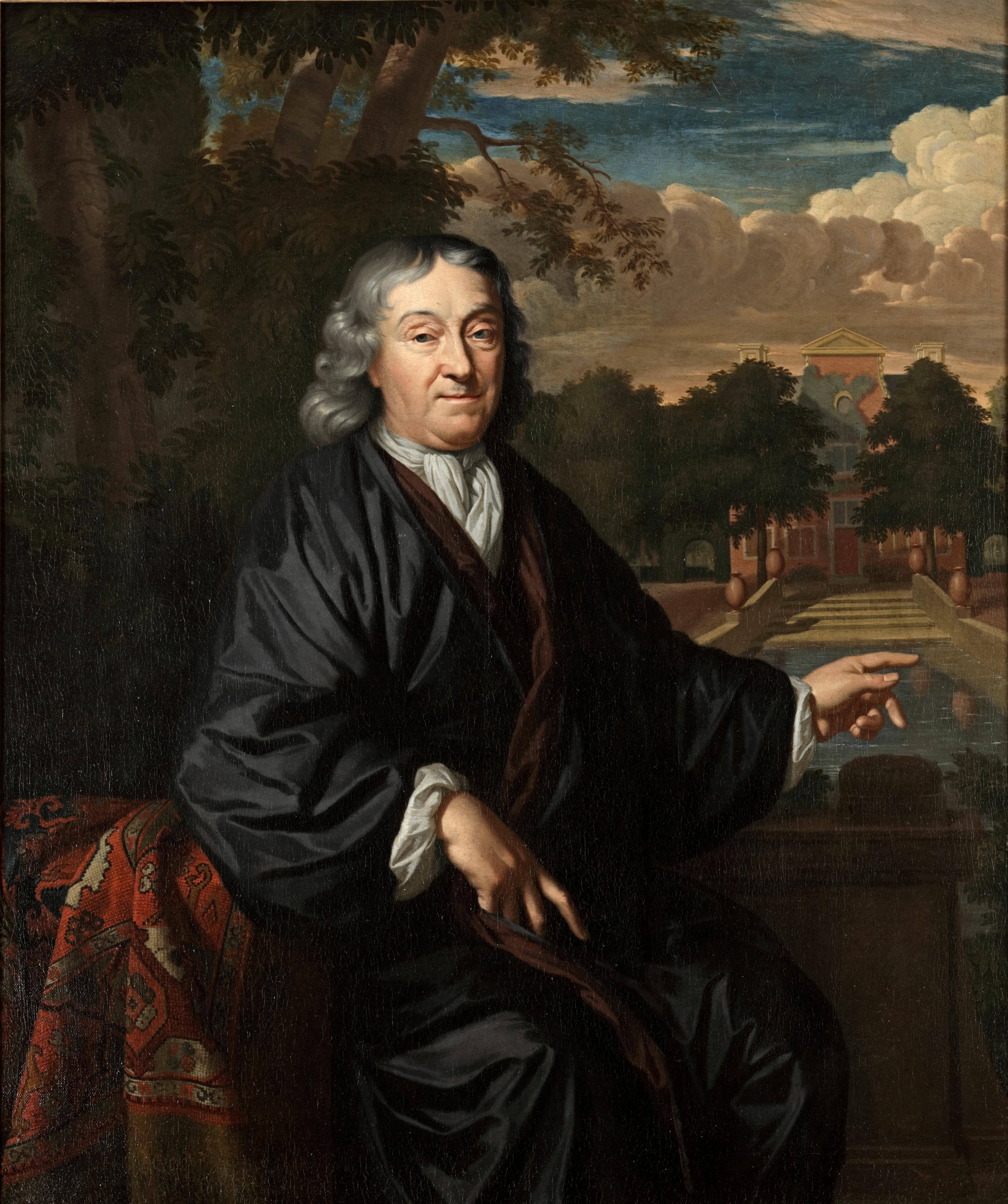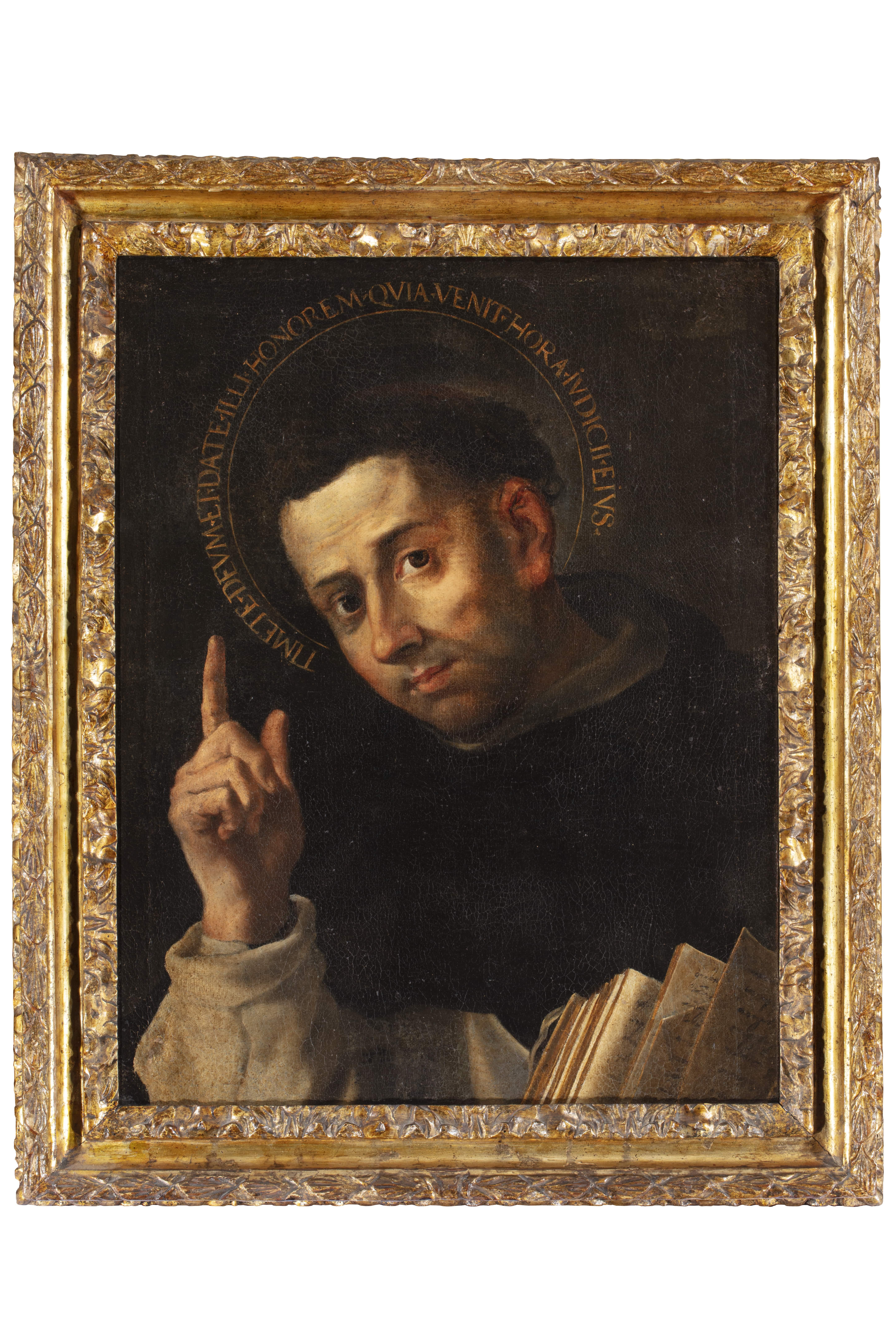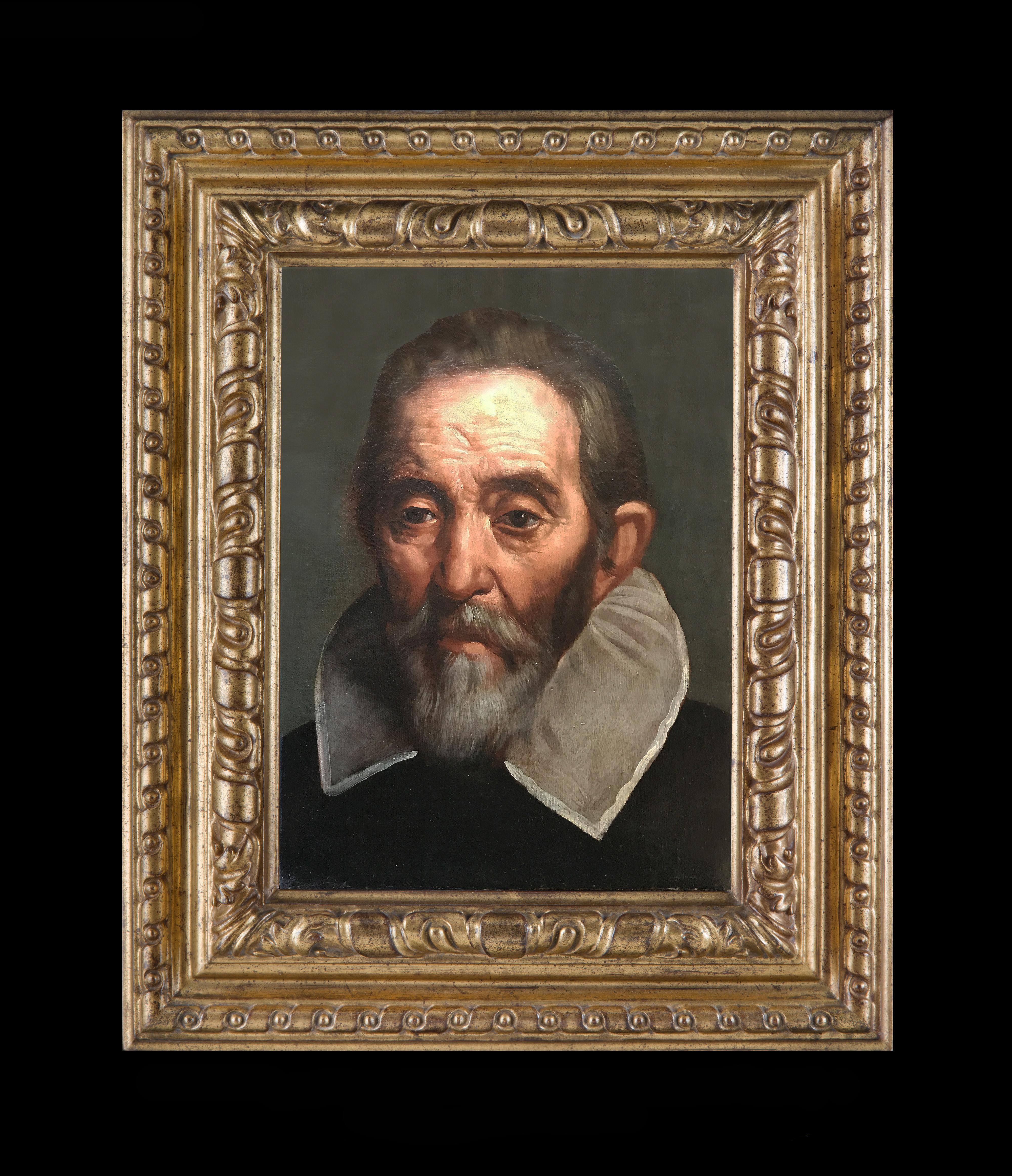Items Similar to Late 17th French School, portrait of a lady, workshop of N. de Largilliere
Want more images or videos?
Request additional images or videos from the seller
1 of 19
Late 17th French School, portrait of a lady, workshop of N. de Largilliere1690
1690
About the Item
A late 17th century French School,
Workshop of Nicolas de Largillière (Paris, 1656-1746)
Circa 1690
This lovely young woman is portrayed at mid-height, disguised as Flora, goddess of flowers, she wears the spring outfit and looks at the viewer with a frankness and a hint of coquetry.
The oval face with delicate features, the almond-shaped gray eyes, her complexion is extremely fresh.
Hair styled "à la Fontanges", her dark brown hair is held back at the nape of the neck, a few curly locks fly in the wind, on her forehead two short locks rolled up on themselves. In the hair the flowers stitched for ornament.
She wears a white satin dress over a blouse adorned with fine lace. Blouse sleeves are rolled up to expose the right forearm.
She is girded with a bodice of gold canvas, embroidered with gold threads, cut into a point and embellished with silver chains.
On her shoulder the garland of flowers which passing behind her back reappears on the other side of the waist falling on the front.
A large pink shawl with iridescent reflections covers her raised left arm and envelopes the figure in the background.
The landscape behind the young woman represents a forest site with autumnal hues under a cloudy sky dotted with clearings.
Oil on original canvas
Dimensions:
Canvas: h. 31.5 in, w. 24.80 in
Beautiful and large original carved giltwood frame.
Framed: h. 40.55 in, w. 33.85 in
Our canvas is a magnificent work painted in the studio of Nicolas de Largillière. An aesthetic force is combined with the charm and youth of the model.
Following the typical composition of the works of Nicolas de Largillière, the painter installs the young woman against the backdrop of a forest with the accents of autumn. Dressed in rich finery, the accent is on floral ornaments, highlighting her natural grace and her porcelain white flesh. As usual, the painter plays with contrasts thanks to strong lighting which makes the young woman radiant and sumptuous.
The mythological disguise adopted in the ceremonial portraits by Louis XIV enchanted the female clientele of Nicolas de Largillière, because fortunately deification no longer belonged to the princes of the blood alone. The painter proposed a repertoire of goddesses generally composed of Diana, Venus, Iris and Flora. The latter was chosen for its symbolism of fertility and blooming youth. The criteria that must have seduced our young aristocrat, full of grace and beauty, whose identity is unfortunately missing.
Nicolas de Largilliere (Paris, 1656-1746)
Born in Paris, Nicolas de Largilliere spent his childhood in Antwerp. Trained there in the studio of Antoine Goubeau, who taught him the study from nature, Nicolas de Largillierre remained faithful to his precepts throughout his career. In 1673 he went to England where he worked as an assistant in the studio of the portrait painter Peter Lely for almost seven years. He was approved by the Royal Academy upon his return to France in 1683 and was received three years later as "painter of portraits and history"). The portrait is by far the genre that dominates an immense production of nearly 1,500 works produced in a workshop through which many renowned painters will pass. He is with Rigaud the most brilliant portraitist of the end of the XVIIth and the beginning of the XVIIIth century. Rigaud, however, is the official court portraitist, Largillierre works mainly for a wealthy bourgeois clientele. His work brilliantly illustrates the French high society under the reigns of Louis XIV and Louis XV, by an exceptional sense of observation he was able to render, sometimes without complacency, the individuality of the faces and the psychology of the characters.
- Attributed to:Nicolas de Largillière (1656 - 1746, French)
- Creation Year:1690
- Dimensions:Height: 40.55 in (103 cm)Width: 33.86 in (86.01 cm)
- Medium:
- Movement & Style:
- Period:Late 17th Century
- Condition:Very good original condition, cleaned and revarnished by our professionnal art restorer.
- Gallery Location:PARIS, FR
- Reference Number:1stDibs: LU2433212155752
About the Seller
No Reviews Yet
Vetted Seller
These experienced sellers undergo a comprehensive evaluation by our team of in-house experts.
1stDibs seller since 2023
- ShippingRetrieving quote...Ships From: PARIS, France
- Return PolicyA return for this item may be initiated within 3 days of delivery.
More From This SellerView All
- 17th French Portrait of Louis XIV & his brother, c. 1645, attributed to BeaubrunLocated in PARIS, FRRare double portrait depicting Louis XIV and his brother Philippe de France as children. 17th century French School, circa 1645, attributed to Charles and Henri Beaubrun. Oil on canvas, dimensions: h. 48.03, w. 35.43 in. Important 17th century carved and giltwood frame Framed dimensions: h. 60.23, w. 48.42 in. This rare portrait is part of a series of works illustrating the childhood of the two princes, mainly commissioned by Anne of Austria, the mother and regent, after the death of Louis XIII. Expressing her fierce desire to preserve her son's crown, she uses visual communication as a channel of sovereign expression. The portraits serve to strengthen the royal power weakened by the minority of the young Louis...Category
Mid-17th Century Old Masters Portrait Paintings
MaterialsCanvas, Oil
- 18th c. French Portrait of Princess of Bourbon as Hebe, Pierre Gobert, c. 1730By Pierre GobertLocated in PARIS, FRPortrait of Princess of Bourbon as Hebe Pierre Gobert, circa 1730 Presumed portrait of Elisabeth Thérèse Alexandrine of Bourbon-Condé, Mademoiselle de Sens, depicted as the goddess Hebe kidnapped by Zeus, transformed into an eagle. 18th century French School, around 1730 Pierre Gobert (1662-1744) and workshop Oil on canvas Dimensions: canvas: h. 129 cm, w. 95cm Dimensions: framed: h. 156 cm, w. 124cm Louis XIV style giltwood and cardved wood frame Large and imposing portrait of the young princess portrayed seated on an eagle in the heavens. Seen from the front, the princess is dressed in a low-cut white chiffon dress, exposing her throat. Delicately made-up oval face, dominated by large blue-gray eyes is surrounded by powdered hair, raised, releasing the forehead and the ears, and of which some locks fall on his shoulder. A large blue scarf passed over the shoulder covers her knees and flies in the wind. A garland of flowers coming from the back goes over the knees and down again on the eagle. In her right hand she holds a golden goblet and in her left hand an ewer. The eagle supporting the young woman seizes in its claws the thunderbolt (the beam of fiery lightning), the attribute of Zeus. The figure of the young woman is enlivened by the fluidity of the antique drapes...Category
Early 18th Century Old Masters Portrait Paintings
MaterialsCanvas, Oil
- French, circa 1730 Portrait of King Louis XV in armour, workshop of J.B. Van LooLocated in PARIS, FRPortrait of French King Louis XV (1710-1774) in armour 18th century French school Workshop of Jean Baptiste Van Loo (1684-1745) Circa 1730 Oil on canvas, dimen...Category
Early 18th Century Old Masters Portrait Paintings
MaterialsCanvas, Oil
- 18th c. French Portrait of a Lady as Venus, attributed to Pierre GobertBy Pierre GobertLocated in PARIS, FRPortrait of a Lady as Venus ATTRIBUTED TO PIERRE GOBERT (1662-1744) FRENCH SCHOOL AROUND 1720 OIL ON CANVAS: H. 55.51 in, W. 42.91 in. IMPORTANT 18TH CENTURY GILTWOOD FRAME (RE-GILT)...Category
Early 18th Century Old Masters Portrait Paintings
MaterialsCanvas, Oil
- Portrait of count Evreux, French, 18th c. studio of Hyacinthe Rigaud, circa 1705By Hyacinthe RigaudLocated in PARIS, FRPortrait of Henri-Louis de la Tour d'Auvergne, Comte d'Evreux Studio of Hyacinthe Rigaud (1659-1743) Early 18th century French school, circa 1705 Oil on canvas Dimensions: h. 72 cm, w. 57.5 cm Louis XIV period gilded and richly carved wood frame with flowered corners. Framed: h. 96 cm, w. 80 cm Henri-Louis de la Tour d'Auvergne (1679-1753), Count of Evreux at the age of 24. The young man is depicted standing, seen at mid-height, turned three-quarters, against a background of a sky filled with cannon smoke. Head turned to the left, a large wig falling over his shoulders, a youthful face with plain cheeks, a delicate smile from thin lips, a gentle, benevolent facial expression. The right hand rests on the command staff in the foreground, while the left arm is bent and the hand rests on the hip. He is wearing a white sash of command, the floating drapery of which appears to his right. Fully armored, his only visible adornments are the blue velvet facings at the joins of the armor pieces and the sleeves of fine white lace. Power and charisma emanate from this military portrait. The young man's stature, bearing and head carriage convey the image of a valiant warrior. The theatrical lighting abundantly illuminates the face and creates strong metallic reflections in the armor. Despite his static stance, the hair blowing in the wind enlivens the painting, lending a dynamism and vigor that amplify the model's belligerent attitude. Our work is a studio version by Hyacinthe Rigaud, the original of which was executed by the artist himself in 1703. This original portrait of the Comte d'Evreux is now housed in the Gemälde Galerie - Alte Meister in the collections of the Kassel Museum. This portrait, one of the artist's most successful, was exhibited in 1704 at the Salon de l'Académie des Beaux-Arts and received rave reviews. As for the Compte d'Evreux, as soon as the original was created, he was satisfied with the artist's work and directly commissioned several replicas, which were executed by the studio between 1703 and 1705. These studio versions, as in the case of our painting, were intended as gifts from the Count to his wartime companions or members of his family. Our work is listed in the catalog raisonné of Hyacinthe Rigaud written by the artist's specialist Mr. Stéphane Perreau (published in 2004) Provenance: former private collection in Dijon, Burgundy Henri-Louis de la Tour d'Auvergne, le comte d'Evreux was the fourth son of the Duc de Bouillon, Godefroy-Maurice de La Tour...Category
Early 18th Century Old Masters Portrait Paintings
MaterialsCanvas, Oil
- 18th c. French Portrait of Louise Dorothea von Hoffman, signed H. Millot, 1724Located in PARIS, FRHENRI MILLOT PORTRAIT OF LOUISE-DOROTHÉE VON HOFFMAN Signed “h. millot” and dated 1724 on the back of the original canvas Henri Millot, French painter (Paris, active between 1699 an...Category
Early 18th Century Old Masters Portrait Paintings
MaterialsCanvas, Oil
You May Also Like
- Portrait of a GentlemanLocated in New York, NYCircle of Jacques-Louis David (French, 18th Century) Provenance: Private Collection, Buenos Aires Exhibited: “Art of Collecting,” Flint Institute of Art, Flint, Michigan, 23 November 2018 – 6 January 2019. This vibrant portrait of young man was traditionally considered a work by Jacques-Louis David, whose style it recalls, but to whom it cannot be convincingly attributed. Rather, it would appear to be by a painter in his immediate following—an artist likely working in France in the first decade of the nineteenth century. Several names have been proposed as the portrait’s author: François Gérard, Louis Hersent, Anne-Louis Girodet (Fig. 1), Theodore Gericault, and Jean-Baptiste Wicar, among others. Some have thought the artist Italian, and have proposed Andrea Appiani, Gaspare Landi...Category
18th Century Old Masters Paintings
MaterialsCanvas, Oil
- Portrait of a Lady with a ChiqueadorLocated in New York, NYProvenance: Torres Family Collection, Asunción, Paraguay, ca. 1967-2017 While the genre of portraiture flourished in the New World, very few examples of early Spanish colonial portraits have survived to the present day. This remarkable painting is a rare example of female portraiture, depicting a member of the highest echelons of society in Cuzco during the last quarter of the 17th century. Its most distinctive feature is the false beauty mark (called a chiqueador) that the sitter wears on her left temple. Chiqueadores served both a cosmetic and medicinal function. In addition to beautifying their wearers, these silk or velvet pouches often contained medicinal herbs thought to cure headaches. This painting depicts an unidentified lady from the Creole elite in Cuzco. Her formal posture and black costume are both typical of the established conventions of period portraiture and in line with the severe fashion of the Spanish court under the reign of Charles II, which remained current until the 18th century. She is shown in three-quarter profile, her long braids tied with soft pink bows and decorated with quatrefoil flowers, likely made of silver. Her facial features are idealized and rendered with great subtly, particularly in the rosy cheeks. While this portrait lacks the conventional coat of arms or cartouche that identifies the sitter, her high status is made clear by the wealth of jewels and luxury materials present in the painting. She is placed in an interior, set off against the red velvet curtain tied in the middle with a knot on her right, and the table covered with gold-trimmed red velvet cloth at the left. The sitter wears a four-tier pearl necklace with a knot in the center with matching three-tiered pearl bracelets and a cross-shaped earing with three increasingly large pearls. She also has several gold and silver rings on both hands—one holds a pair of silver gloves with red lining and the other is posed on a golden metal box, possibly a jewelry box. The materials of her costume are also of the highest quality, particularly the white lace trim of her wide neckline and circular cuffs. The historical moment in which this painting was produced was particularly rich in commissions of this kind. Following his arrival in Cuzco from Spain in the early 1670’s, bishop Manuel de Mollinedo y Angulo actively promoted the emergence of a distinctive regional school of painting in the city. Additionally, with the increase of wealth and economic prosperity in the New World, portraits quickly became a way for the growing elite class to celebrate their place in society and to preserve their memory. Portraits like this one would have been prominently displayed in a family’s home, perhaps in a dynastic portrait gallery. We are grateful to Professor Luis Eduardo Wuffarden for his assistance cataloguing this painting on the basis of high-resolution images. He has written that “the sober palette of the canvas, the quality of the pigments, the degree of aging, and the craquelure pattern on the painting layer confirm it to be an authentic and representative work of the Cuzco school of painting...Category
17th Century Old Masters Paintings
MaterialsCanvas, Oil
- Male and female portrait, both in silk kimono, possibly textile dealersBy Christoffel LubienieckiLocated in Amsterdam, NLCHRISTOFFEL LUBIENIECKI (1659-1729) Pair of portraits of a gentleman and a lady, both in silk kimono, before a country house (circa 1680) Indistinctly signed “C.......” on a box under the man’s left hand Oil on canvas, 79.5 x 67 cm each Both sitters are portrayed wearing a silk “Japanese” coat. During the second half of the seventeenth the Japanese silk coat, an adapted Japanese kimono, became a real vogue in the Dutch elite. The exclusive Dutch trade contacts with Japan can explain the popularity of the kimono-style silk coats in the Netherlands. Everybody who could afford one, dressed in such a fashionable and comfortable coat and, like the present sitters, some proud owners had themselves portrayed in a “Japanese” coat often together with an oriental carpet to underline their standing and international connections. These portraits are the work of the Polish-born portraitist Christoffel Lubieniecki (also known as Lubienitski, Lubinitski or Lubiniecki) Lubieniecki was first trained in Hamburg under Julian Stuhr and after 1675 in Amsterdam under Adriaen Backer and Gerard de Lairesse. He specialized in landscapes, generally of an Italianate character, and in portraits. The loving execution of these contented burghers, enjoying the garden vistas of their country house, places him alongside Amsterdam portraitists such as Constantijn Netscher and Michiel van Musscher...Category
1680s Old Masters Portrait Paintings
MaterialsCanvas, Oil
- 17th century By Neapolitan maestro San Vincenzo Ferreri Oil on canvasLocated in Milano, Lombardia“Timete Deum et date Illi honorem quia venit hora iudicii Eius” (Fear the Lord and honour Him, for the hour of His judgement has come): the passage from John's Apocalypse (chapter 14...Category
17th Century Old Masters Portrait Paintings
MaterialsCanvas, Oil
- 16th Century by Bernardino Detti Face of Christ Oil on CanvasLocated in Milano, LombardiaDimensions: 41 x 32 cm without frame - 47 x 55.5 cm with frame Antique box frame made of solid wood and walnut burl. Publications: unpublished The painting by Bernardino Detti (14...Category
16th Century Old Masters Figurative Paintings
MaterialsCanvas, Oil
- Ritratto di Uomo di LeggeLocated in Balerna, TIMarcantonio Bassetti (Verona 1586-1630) Ritratto di uomo di legge Olio su tela, cm 38x27,5; con cornice cm 59,5x48,5 Le caratteristiche pittoriche della persona ritratta sembrano rin...Category
17th Century Old Masters Portrait Paintings
MaterialsCanvas, Oil





